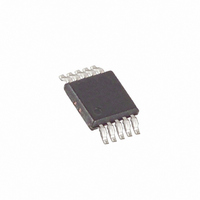MAX1957EUB+ Maxim Integrated Products, MAX1957EUB+ Datasheet - Page 18

MAX1957EUB+
Manufacturer Part Number
MAX1957EUB+
Description
IC CNTRLR PWM BUCK 10-UMAX
Manufacturer
Maxim Integrated Products
Type
Step-Down (Buck)r
Datasheet
1.MAX1954EUB.pdf
(22 pages)
Specifications of MAX1957EUB+
Internal Switch(s)
No
Synchronous Rectifier
Yes
Number Of Outputs
1
Voltage - Output
0.4 ~ 4.73 V
Current - Output
3A
Frequency - Switching
300kHz
Voltage - Input
3 ~ 5.5 V
Operating Temperature
-40°C ~ 85°C
Mounting Type
Surface Mount
Package / Case
10-MSOP, Micro10™, 10-uMAX, 10-uSOP
Power - Output
444mW
Duty Cycle (max)
89 %
Output Voltage
0.4 V to 4.73 V
Output Current
3000 mA
Mounting Style
SMD/SMT
Switching Frequency
300 KHz
Maximum Operating Temperature
+ 85 C
Minimum Operating Temperature
- 40 C
Synchronous Pin
No
Topology
Boost, Buck
Lead Free Status / RoHS Status
Lead free / RoHS Compliant
The MAX1953/MAX1954/MAX1957s’ response to a load
transient depends on the selected output capacitors. In
general, more low-ESR output capacitance results in
better transient response. After a load transient, the
output voltage instantly changes by ESR
Before the controller can respond, the output voltage
deviates further, depending on the inductor and output
capacitor values. After a short period of time (see the
Typical Operating Characteristics), the controller
responds by regulating the output voltage back to its
nominal state. The controller response time depends on
its closed-loop bandwidth. With a higher bandwidth,
the response time is faster, preventing the output volt-
age from further deviation from its regulating value.
The MAX1953/MAX1954/MAX1957 use an internal
transconductance error amplifier whose output com-
pensates the control loop. The external inductor, high-
side MOSFET, output capacitor, compensation resistor,
and compensation capacitors determine the loop sta-
bility. The inductor and output capacitors are chosen
based on performance, size, and cost. Additionally, the
compensation resistor and capacitors are selected to
optimize control-loop stability. The component values
shown in the Typical Application Circuits (Figures 1
through 4) yield stable operation over the given range
of input-to-output voltages and load currents.
The controller uses a current-mode control scheme that
regulates the output voltage by forcing the required
current through the external inductor. The MAX1953/
MAX1954/MAX1957 use the voltage across the high-
side MOSFET’s on-resistance (R
inductor current. Current-mode control eliminates the
double pole in the feedback loop caused by the induc-
tor and output capacitor, resulting in a smaller phase
shift and requiring less elaborate error-amplifier com-
pensation. A simple single-series R
is needed to have a stable high bandwidth loop in
applications where ceramic capacitors are used for
output filtering. For other types of capacitors, due to the
higher capacitance and ESR, the frequency of the zero
created by the capacitance and ESR is lower than the
desired close loop crossover frequency. Another com-
pensation capacitor should be added to cancel this
ESR zero.
The basic regulator loop may be thought of as a power
modulator, output feedback divider, and an error ampli-
fier. The power modulator has DC gain set by g
R
put capacitor (C
tance (R
Low-Cost, High-Frequency, Current-Mode PWM
Buck Controller
18
LOAD
______________________________________________________________________________________
, with a pole and zero pair set by R
ESR
).
OUT
), and its equivalent series resis-
Compensation Design
DS(ON)
C
and C
) to sense the
LOAD
C
✕
is all that
, the out-
I
LOAD
mc
x
.
Below are equations that define the power modulator:
where R
R
amplifier and R
side power MOSFET. A
ILIM is connected to GND, and 3.5 for the MAX1954/
MAX1957 and for the MAX1953 when ILIM is connect-
ed to V
and zero due to the power modulator occur are deter-
mined as follows:
The feedback voltage-divider used has a gain of G
V
ductance error amplifier has DC gain, G
R
compensation capacitor (C
resistance (R
zero is set by the compensation resistor (R
compensation capacitor (C
There is an optional pole set by C
output capacitor ESR zero if it occurs before crossover
frequency (f
The crossover frequency (f
than the power modulator pole f
crossover frequency should be less than 1/5 the
switching frequency:
DS(ON)
FB
O
f
f
pMOD
zMOD
. R
/V
OUT
O
IN
is typically 10M . A dominant pole is set by the
), where A
LOAD
, where V
or floating. The frequencies at which the pole
2
2
G
C
O
MOD
):
f
fzEA
fpEA
pdEA
= V
), and the compensation resistor (R
DS(ON)
C
C
OUT
OUT
OUT
f
pMOD
CS
1
FB
g
2
2
mc
/I
2
is the gain of the current-sense
is the on-resistance of the high-
is equal to 0.8V. The transcon-
CS
OUT(MAX)
R
R
ESR
is 6.3 for the MAX1953 when
C
C
C
LOAD
C
C
).
1
1
C
R
f
f
R
) should be much higher
C
C
C
R
LOAD
LOAD
1
), the amplifier output
LOAD
, and g
1
f
R
R
f
5
S
and R
(
C
C
R
f
S
O
pMOD
(
f
f
S
f
S
S
mc
EA(DC)
C
R
L
to cancel the
C
. Also, the
)
= 1/(A
L
L
C
L
)
R
) and the
ESR
= gm
C
CS
FB
). A
=
✕
✕











